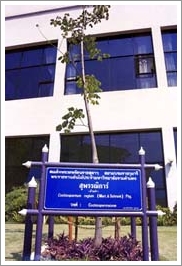|
SUPANNIGAR (GANNIGAR, FAIKHAM)
|
We were greatly honoured by Her Royal Highness Princess Maha Chakri Sirindhorn’s gift of a Supannigar tree given on the 18th January 1999 and Her Royal Highness intention for the tree as a Symbol of Ramkhamhaeng University. To this effect we have planted Supannigar tree in front of the University Hall for all to see and admire. SUPANNIGAR (GANNIGAR, FAIKHAM)
Originally from the North West of India near the Himalayan mountains, it is also synonymous with Burma. In Sri Lanka it is popularly planted in the temples and the flowers are used to adore the monk similarly to the way a lotus is used in Thailand. It was introduced to Northern Thailand some 50 years ago, where it is called “Fai kham”. The tree reaches 7-15 meters in height at maturity and when the tree blossoms the leaves fall,thus giving rise to the literal Thai name of “The tree that has no leaf when the blossoms arrive.” The branches are not straight but grow in unusual twisted forms. The leaves are heart shaped with 5 smooth serrated edges. Bunches of thin petaled yellow blossoms grow at the end of the branches,flowering one after the other.The fragrance is particularly sweet and pleasant. After blossoming the flower turns into a brown “fruit”before cracking open to reveal a kidney shaped seed surrounded by Kapok. The tree blossoms virtually all year round but is particularly beautiful in February and April.
Propagation : Propagation can be carried out in 2 ways. a. Planting young cuttings. b. Taking cuttings and wrapping them in damp soil surrounded by coconut fiber. This is a smaller tree which grows to between 3-12 meters at maturity. It is very similar to the Indian variety but the leaves are less serrated and the tree does not have any fragrance. The “fruit” is reddish green.
Propagation : As would be thought the American species is propagated in a similar manner to the Indian variety. A TREE OF MANY USES : The tree is very versatile and has a surprizing number of uses. The blossoms are used of course as decoration. The Karaya Gum (rubber) obtained from the tree is commercially known as Crystalgum. Crystalgum crystals are usually light yellow in colour but can be brown with a pink hue. With added chemicals it can be used as a laxative and as a hair gel. It is also the base for a naturally vitamin enriched skin cream. In the weaving and printing industry it is used as a Lubricant. The food industry uses it to enrich ice-cream and in the preservation of canned food. The young leaves of the tree are used as a conditioning shampoo and for cleaning the hair. Last but not least the dried flower petals are used by many people as a tonic-medicine to strengthen the body and increase health. All in all a most beautiful, interesting and wonderful tree. Translated from Thai to English language by David Gregory. |
||||||
|
ORIGINS Indian Species  |
|||||||
|
South and North American Species
Cochlospermum regium (Mart. & Schrank) Pilg. |
| BIBLIOGRAPHY | พรรณไม้ในสวนหลวง ร.9. 2531. กรุงเทพฯ : มูลนิธิสวนหลวง ร.9. สารานุกรมไม้ประดับในประเทศไทย. 2524. กรุงเทพฯ : กองบรรณาธิการบ้านและสวน. อำนวย ปิ่นรัตน์. 2516. ดอกไม้เมืองไทย เล่ม 2. กรุงเทพฯ : วีรธรรม. |


 Butter-Cup (Single) Fai kham
Butter-Cup (Single) Fai kham


